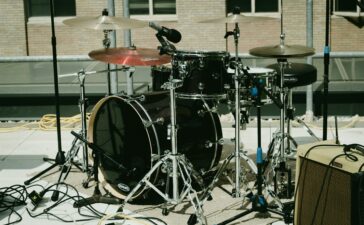Are you sick and bored of how everyone else’s guitar sounds? Do you want to be noticed and have a distinctive signature sound? So let’s explore the realm of guitar amps settings, shall we? Having access to so many amp and effect options might make creating your own unique sound seem difficult. But don’t worry! This article will discuss various amp kinds, amp settings, and how to use guitar effects to help you get the sound you want. Prepare to rock out with a unique touch!

The Different Amp Types
Choosing the correct amp is essential if you want to create a distinctive guitar sound. There are various amp kinds on the market, and each one has certain features and qualities that might have an impact on the tone and overall sound you generate.
For most guitarists, tube amps are the standard option. They are well-known for their warm, rich tones and have been around since the beginning of rock ‘n’ roll. They are heavier and more expensive than other solutions, but, on the whole.
Solid-state amplifiers may not have the same personality as tube amplifiers, but they are reliable and offer constant tone quality at any volume level. Modeling amps offer versatility in terms of effects selection while simulating a variety of amp sounds from various eras or genres using digital technology.
Hybrid amplifiers integrate solid-state circuitry with tube technology to produce rich harmonic content that is comparable to pure-tube models while remaining lightweight for portability during practice sessions or performances.
In the end, each guitarist has their own preferences when it comes to picking the amplifier that best suits them based on a variety of considerations like playing style, financial limitations, and more. To ensure that you are delighted with your choice, always do your homework before making any judgements regarding buying one.
Power Settings
The settings on your guitar amp are essential for creating a distinctive sound. The market offers a variety of amp kinds, each with a unique set of features and capabilities. But it’s important to know how to adjust the settings on your particular amplifier.
The gain or drive knob should be your first point of concentration. Your tone’s level of distortion can be adjusted using this, ranging from clean to heavily overdriven. You can experiment with this knob to get the ideal harmony between grit and clarity.
The next step is EQ, also referred to as equalization, which modifies the sound’s frequencies. Most amplifiers contain treble, midrange, and bass knobs that help you adjust your tone to suit your tastes or the genre.
Reverb for adding depth to your sound, presence for modifying high-end frequencies, and volume controls for overall loudness are other crucial variables.
Avoid becoming overawed by the sheer number of options available and instead spend some time exploring with each setting separately until you find a harmonious blend that complements both your guitar and playing style. With time and effort, you’ll be able to dial in those distinctive sounds!

Music Effects
Using guitar effects pedals helps enhance your distinctive sound. These tiny magical boxes have the power to change the loudness, tone, and even add new textures to your performance. Guitar effects come in a wide variety of forms and cater to numerous musical genres and styles.
Distortion/overdrive is a well-liked effect that gives your guitar’s natural tone a gritty edge. Rock, blues, or heavy metal tones fit it perfectly. Delay pedals produce an echo-like effect that gives solos and chords an ambient feel. Reverb creates a sense of depth and distance by mimicking a room’s acoustics.
Chords or single notes gain motion and character through the use of modulation effects like chorus, phaser, or flanger. Wah pedals reproduce the wah-wah tone made popular by Jimi Hendrix and other legendary guitarists.
To preserve the authenticity of your playing style, it’s crucial to avoid overusing these effects, but a subtle usage of them can make your music production stand out. Trying out various combinations can take you down avenues you never imagined were open to you!
In the end, developing a signature sound involves more than just tweaking certain settings; it also involves figuring out what suits you the most as a musician and giving yourself the opportunity to grow and explore. So keep adjusting those knobs until you achieve the ideal equilibrium between technique, equipment, originality, and most importantly, heartfelt musical expression!





